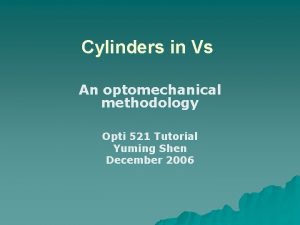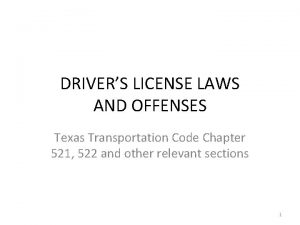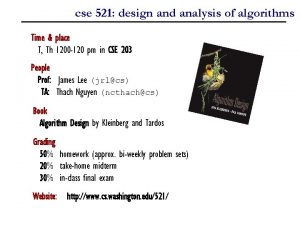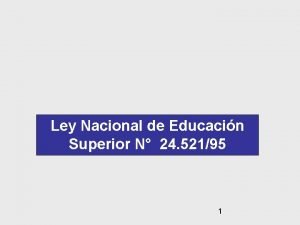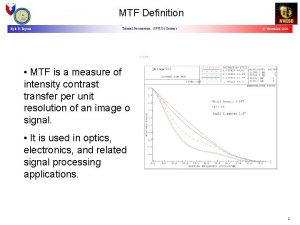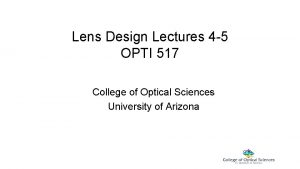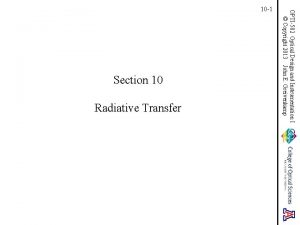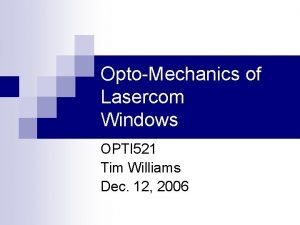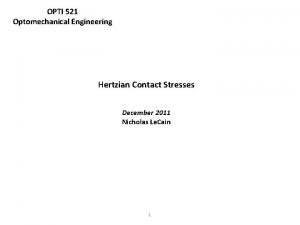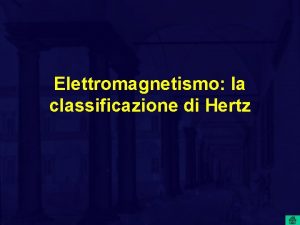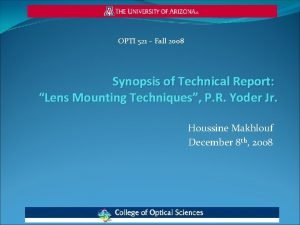HERTZ CONTACT STRESS THEORY UA Optomechanics OPTI 521













- Slides: 13

HERTZ CONTACT STRESS THEORY UA Optomechanics OPTI 521 Jacob Etter December 13, 2011

Introduction Background Theory and Mathematics Contact Mechanics Summary and Conclusions

Mechanics of Materials Typical Stress Theory Shows That for An Element Subject to Axial Load Images taken from Wikipedia: http: //en. wikipedia. org/wiki/Contact_mechanics What Happens When Spherical or Cylindrical Surfaces Contact? Point or Line Contact Results A 0 so σ ∞ Image taken from Contact Mechanics, K. L. Johnson

Solids in Contact In Reality, Under Load the Objects Deform Giving a Contact Area a << R A Theory was Required to Predict the Shape of the Contact Area as well as: Area Growth Under Increasing Load Stress and Deformation in Both Bodies Hertz Developed First Analysis of Stress in Two Elastic Solids in Contact

Hertzian Contact Stress Theory 1880 Hertz Developed a Theory of the Elastic Deformation of Two Surfaces in Contact Formulated After Studying Newton’s Interference Fringes Between Two Glass Lenses Simplifying Assumptions Surface are Continuous and Non-Conforming Strains are Small Surfaces are Frictionless Solids are Operating in the Elastic Regime

Geometry and Material Properties Considering the Two Cases Shown Previously From the Geometry of the Solids we Calculate an Effective Radius, Similarly, From the Material Properties, An Effective Modulus of Elasticity Can Be Established,

Contact Mechanics The Contact Area of Two Solids Under a Given Load Can Be Shown To Be, The Maximum Pressure Occurs at the Center and is Shown To Be, The Compression of the Two Solids Can Also Be Determined As,

Contact Stress The Principle Stresses in the Material Occur in the Orthogonal Planes σx = σ1 , σy = σ2 , σz = σ3 At Maximum Pressure the Stress in the Normal Direction is Given By, Stress in the Orthogonal Directions is Shown to be, Maximum Shear Stress is,

Relation to Optics In Optics Several Situations Arise Where Contact Stress Must Be Considered Lens Seats Kinematic Constraints

Sharp Corner Lens Seat Consider a Spherical Lens in a Sharp Corner Seating Lens Creates Ring Contact As a Pre-Load is Applied Stress is Induced in the Glass and the Seat Glass and Seat Must be Analyzed Under This Load and Any Other Induced Loads

Kinematic Constraint Used for Precision Motion and Alignment Controls Chosen Degrees of Freedom Contact Stress Can Degrade Precision

Summary Two Non-Conforming Solids in Contact Can Result is High Stresses Small Contact Area Hertz Developed a Theory for Contact Stress Allows for Prediction of Contact Area, Pressure, Compression and Stress Contact Stress Becomes a Significant Consideration for Optics Lens Mounting Precision Motion and Alignment

Questions?

